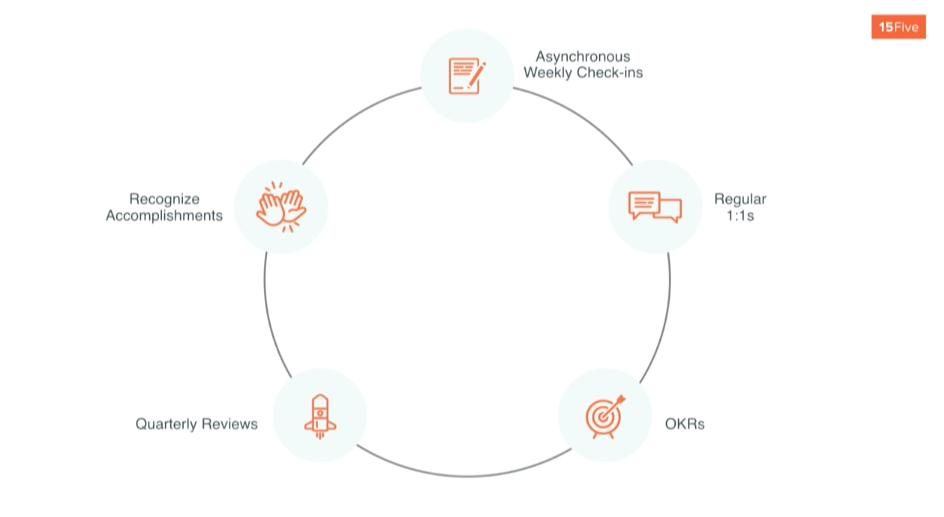How Workplace Feedback Can Create A Cultural Revolution At Your Company
How many times have you heard the phrase, “communication is key?” If you’re anything like me, the advice has now become trite, losing any significance or weightiness it once had. But ignoring this advice with any relationship can be detrimental to the deep connection you are trying to
create with another person.
When we aren’t intentional with the way we communicate, things can turn sour quickly. In a workplace, and really anywhere, gossip and negative speech can disintegrate any trust or motivation that may have once been granted. Delivering feedback in the workplace has the ability to communicate where an employee struggles, and receiving it can help you as a manager or leader to become a better version of yourself.
I recently spoke at a From Day One conference and shared why workplace feedback is your missing puzzle piece.
The status quo has taught us that the hierarchy of an organization starts at the top with senior leaders and widens downward towards middle management and junior employees. This command-and-control structure left no room for workplace feedback, as it expected employees to fulfill orders from the top blindly. But the modern business model is moving in a different direction.
By flipping the organizational chart, senior leaders take on the new role of facilitators and coaches. When you see the potential in people, rather than viewing them as expendable resources, you can get to work on maximizing their talents. This has the ability to unlock potential and productivity within every individual at a company. Emotional courage, vulnerability, and creativity are the new drivers of this economy.
Employee Lifetime Value
Most companies today are tracking customer lifetime value. This is how much money it takes to acquire a customer, tracking how long customers are staying and how much money they are spending. From these metrics, businesses are able to find gaps in their productivity so they can proactively create solutions. This system of measurement is effective and should be used internally as well.
Your employee lifetime value should be as closely monitored as your customers. Not only is the absence of a rockstar employee who leaves out of the blue felt deeply, but on average, the cost of replacing someone can range from tens of thousands of dollars to 1.5-2x their initial annual salary. By keeping a close eye on employee lifetime value, you’ll retain people who are more motivated, productive, and engaged than ever before.
Listening to the wants and needs of your employees will create advocates that are passionate about your company’s mission. These employees are your biggest proponents and the most authentic way to create brand-loyal customers. It really is true what they say; a company is only as good (or extraordinary) as its people.
Business relationships are personal relationships
“We’re moving into the era of the intelligence of the heart” – Claude Silver, Bainer Media
Work-life balance, while nice in theory, is purely a myth. Let’s face it, life is all encompassing, it does not pause for the 8 hours a day that you are working. And if we’re being honest with ourselves, most of us are averaging far more than 40 hour weeks.
It’s safe to say that our work occupies about half of our lives, and if that statement upsets you, I invite you to shift your perspective. If we treat our lives at work as a separate entity, we will find ourselves going through the motions and missing out on some of life’s best experiences. So, my advice to you is… don’t separate it.
Build meaningful relationships with the people you see on a daily basis, and eliminate the category of “business relationship.” No matter how or where you make relationships, they are all personal because the common denominator is you.
Relationships impact our everyday lives and allowing for honest feedback will strengthen the quality of these connections. It’s through these relationships that strong foundations for great companies are built, and personal success can reach higher heights.
Strengthening emotionally intelligent connections is an unorthodox metric to measure, but these vital aspects of human life should be a top priority. With the use of strategic employee 1-on-1s, continuous learning and development, and honest workplace feedback, you can begin practicing emotional intelligence at work and gain new skills that can be woven into other parts of your life.
The Golden Ratio of Feedback
American psychological researcher and clinician, Dr. John Gottman, has studied relationships for the past 40 years. In one of his studies, he asked couples to resolve their conflicts in front of him and was able to predict with 90% accuracy if a couple would beat the test of time and remain together for years to come. If you had to read that twice, I don’t blame you.
Dr. Gottman was able to make these predictions after discovering the antidote to conflict was a specific ratio between positive and negative interactions, thus the Golden Ratio of Feedback was conceived.
The Golden Ratio of Feedback says that for every one negative interaction, you must have five emotionally positive interactions to balance it.
“Negative interactions during conflict include being emotionally dismissive or critical, or becoming defensive. Body language such as eye-rolling can be a powerful negative interaction, and it is important to remember that negativity holds a great deal of emotional power, which is why it takes five positive interactions to overcome any one negative interaction,” says Dr. Gottman.
During the course of a workday, many negative interactions can take place. Maybe it’s a passive aggressive email, or your great idea was cut short in a meeting, or maybe an uncomfortable conversation took place with your manager. These negative interactions are incredibly draining, and can do a number on your mental state.
To counteract this negativity, begin with appreciation. Appreciation fulfills so many human needs and creates a culture of belonging. And while this is an easy first step, most organizations are appreciation-deficient. For many years, the false idea that showing appreciation would make your employees “soft” or entitled have driven the harsh cultures that so many organizations still have today. This is not the psychologically safe environment that people crave today.
Managers, when giving feedback to your employees, don’t forget to first recognize them for their accomplishments. We often focus on the bad, when really there are so many more wins throughout a single day than there are fixes to be made. Implement this and it will become contagious throughout the workplace and even beyond the office walls.
How to incorporate a cycle of workplace feedback
Growth doesn’t happen overnight, and it certainly doesn’t happen without the help and buy-in of your team. By implementing a structure of workplace feedback, you’ll begin seeing a pattern of heightened productivity and excellent execution. 15Five found that asynchronous weekly check-ins, regular 1-on-1s, OKRs, quarterly reviews, and the recognition of accomplishments create a cyclical habit of success.

Asynchronous weekly check-ins are a time that you and you’re employees are engaging in self-reflection. The focus is not on work as much as it is on one another. Don’t be afraid to ask, “how are you feeling?” By basing the conversation around this question, you’ll spend these moments fostering a deeper connection, getting to the meat of the conversation quicker and therefore leading to more powerful 1-on-1s.
1-on-1 meetings are scheduled times each week that are intended to be career development conversations. During these times, you can discuss your priorities, challenges, wins, what drains you, what excites you… whatever you find important. Through these conversations, you’ll be able to better track your employee’s OKRs.
Tracking your objectives and key results, otherwise known as OKRs, creates alignment around the most important goals. As a senior leader, there are always things to be done but the constant distractions can heavily impede on your time. OKRs point you in the right direction with manageable action items to get you to your goals. These goals can be discussed in your quarterly reviews.
No longer are the once-a-year reviews cutting it. It’s simply not possible to squeeze in every value point over a year’s time in one conversation. Now, quarterly reviews are the way to reorient after each quarter and discuss important items in a timely manner.
So much of our lives are spent working, that separating the professional from the personal won’t actually create a balance, but will add unnecessary complexity. The more hours you spend in one workplace, the more that experience takes a solidified shape in your life. Instead of fighting this or feeling shame over the hours spent on the job, commit to becoming your best self at work everyday and enable your employees to do the same.
Shane Metcalf is Chief Culture Officer at 15Five, continuous performance management software that includes weekly check-ins, objectives (OKR) tracking, peer recognition, 1-on-1s, and 360°reviews. Shane has spent his career studying organizational & human development, which now translates into the high performing 15Five culture.
Photo By:Simon Migaj on Unsplash




